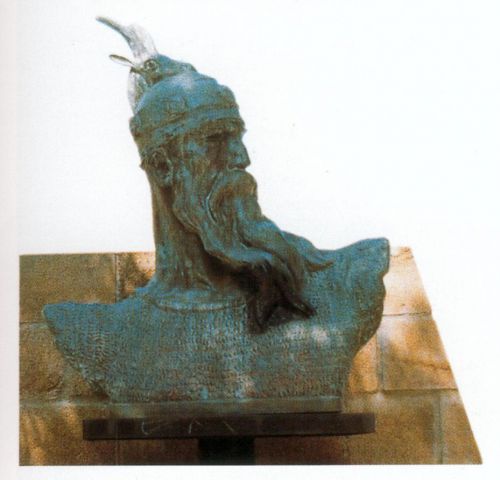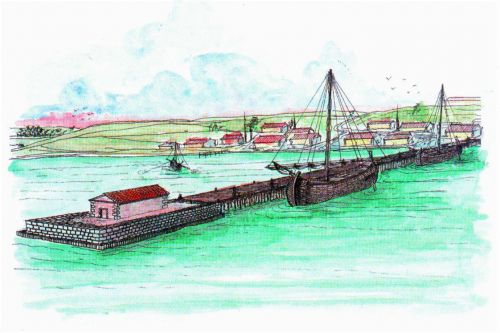Historical Outline
A brief history of the Visigoths to set the scene
The Visigoths came from south-east Sweden (there stills exists the town of Vestergotland) and from the Island of Gottland in the Baltic Sea. Well before the birth of Jesus Christ they were known as traders, travelling as far south as Marseille and Greece.
In the first century they moved south "like a swarm of bees" into Poland, and by the second century had settled near the shores of the Black Sea. Their warriors hired themselves as mercenaries to the Roman army and they prospered, becoming the most Romanised of the "barbarian" peoples, that is, the "strangers" from the north.
Alaric I - this bust of him is on the bridge at Cozenso in Italy, from where he sailed to his death.
But after many changes of Emperor, each more reluctant to pay them than the last, their King, Alaric I, laid siege to Rome and captured it in 410AD. He left Rome though, and died in a storm off the coast of Sicily on his way to Tunisia. His successor Ataulf, negotiated a foedus, which meant he administered the region and sent a proportion of the taxes raised back to Rome, and came to Narbonne in 412. But Ataulf was assassinated and his successor Wallia, claimed Toulouse. There the Visigoths lived for nearly 100 years, during which their king Théodoric's military contribution to a coalition army saved France from the Huns, but cost Théodoric his life.
Their next king, Euric, wanted complete independence and by 507 the Visigothic territory included Aquitaine, Provence, the Narbonnais, today's Catalonia, and most of Spain.
Then the Francs, who had become Roman Catholics, took Aquitaine under Clovis, but they never got Catalonia, Provence or Septimanie, which included Carcassonne, Narbonne, and the Visigoth's secret capital, Rennes-le-Château.
The Roman Port of la Nautique at Narbonne in the time of the Visigoths
Narbonne became especially valuable and the capital of Septimanie, the area approximating to Languedoc today, remained Visigothic until Charles Martel ravaged and desolated the region in 737. Then the Visigoths intermarried with the Carolingians, vastly strengthening Charlemagne's aristocracy.
People still live in Languedoc and the Midi today who can claim Visigothic descent, and Visigothic ideas, such as their legal system, remained in force for another five hundred years.
However, I have met French people today who say they have never heard of the Visigoths. Frankish history had labelled them heretics, destroyed much of their documentation, and re-written French history, making it jump directly from Roman times to Carolingian times.
The Visigothic memory deserves better than this.
In my book "Barbarian Gold" you can read much more with the emphasis on the great treasure that they took from Rome in 410AD.
Inscrivez-vous au site
Soyez prévenu par email des prochaines mises à jour
Rejoignez les 21 autres membres


